What do you do when soot’s in the air, when sparks are flying, when your hands are covered in grease, the HVAC is roaring — and you need to make a call?
You need a phone that is ultra-durable, ultra-reliable and ultra-simple to use.
When you’re looking for a VoIP phone for manufacturing, milling, textile, oil and gas, coal and other challenging environments, you have specific needs that go beyond the typical office desk phone. In this blog, we give you a breakdown of the important features to consider when shopping for a VoIP phone for harsh locations.
Want a primer on VoIP phones in general? Check out our clear, detailed VoIP Phones Buyer’s Guide.
We recommend you start here: durability standards.

Durability Standards: What Does “IP66-Rated” Even Mean?
You’ve seen them: “This phone is IP67-rated.” “This camera is IK10-rated.” “This laptop meets the MIL-STD-810 standard.” What do all these initialisms and acronyms mean?
They refer to a variety of durability standards that cover different situations. For an item to be (honestly) labelled with one of these standards, it must meet strict, independent, objective criteria chosen to replicate real world conditions. In other words, they’re a shorthand guarantee that the item you pay for performs how you expect it to perform.
We’re not going to give full descriptions of what every rating means. We’re just giving you a detailed overview of what kinds of protection the common durability standards measure, so you know what to look for.
What does IP rating mean?
IP ratings specify how well an item prevents foreign materials from entering it: “ingress protection.” IP ratings have two numbers or an X. The first number refers to how well the item prevents against solids from getting into the device; the second number refers to how well it prevents water from getting in. If you see an X (e.g., IP6X), that means that it is unknown how well the item prevents the material from getting in. The higher the number, the better the protection.
When looking for a harsh environment phone, you’ll want to look for a 6 for the first number (as in IP66). That first 6 means the device is tested to be dust-tight; it’s the highest rating. For the second number, you have to judge how much water is present on a regular basis. To take IP66 again, the second 6 means the device is tested to resist high-pressure water jets. The second numbers go up to 9.
What does NEMA rating mean?
Similar to IP ratings are the National Electrical Manufacturers Association (NEMA) ratings. NEMA ratings specify how well enclosures protect electrical equipment. You’ll also see these called NEMA 250 ratings; NEMA rating and NEMA 250 rating refer to the same standard.
NEMA ratings are numbered 1 to 13 plus some letters to indicate additional protection. Unlike with IP ratings, higher NEMA numbers indicate different types of protection, not simply “more” protection.
The most common NEMA rating you’ll see when it comes to phones is NEMA 4X. NEMA 4 means the enclosure is water-tight and the X means it is resistant to corrosion. For outdoor installations exposed to the weather, NEMA 4X is a good standard to look for.
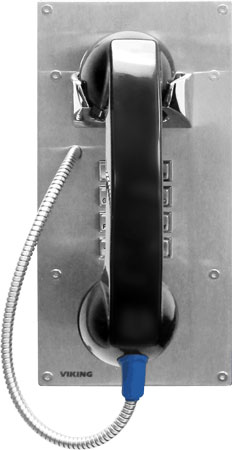
What does IK rating means?
IK ratings specify how well an object resists impacts. They run from IK00 to IK11. (You might come across higher IK ratings, but those aren’t actually part of the current standard.) IK ratings are like IP ratings: the higher the number, the better the protection.
Impacts are measured in joules with a variety of other test characteristics considered, like the radius of the striking object, what kind of hammer is used and so on.
High IK ratings are particularly important to look for in areas with the potential for flying debris. They’re also vital when looking for vandal-resistant phones.
What does MIL-STD-810 mean?
MIL-STD-810 is, as you might guess, a US military standard. It specifies a wide range of tests that replicate the conditions an item will face during the course of its lifetime. The goal is to ensure the item is field-ready in military conditions. There are nearly 30 tests; the item may or may not be tested for all of them.
The standard has been updated numerous times since it was first specified in 1962. The different updates are indicated by letters. The most recent standard is MIL-STD-810H, though you still see MIL-STD-810G frequently. The differences between the two are mostly to improve measurements and clarify definitions. In other words, you don’t need to worry about whether it’s G or H. This standard is also referred to as Mil-Spec 810 or even just Military-Grade or Military Standard, so if you see the term “military-grade VoIP phone,” more than likely it’s referring to a VoIP phone that meets the MIL-STD-810 standard.
In our experience, when manufacturers of VoIP devices refer to MIL-STD-810, they’re not referring to fungus resistance (which they could be since it’s covered in the standard). They’re referring to a device’s ability to withstand drops onto hard surfaces. This could be very important in certain environments. However, as you can tell, this is a fuzzy standard compared to the other ones, so you have to look into the specific claims made when a device is labelled MIL-STD-810.
What does UL approved mean?
For hazardous locations, there are a host of more stringent standards. One that you’ll come across frequently is UL (e.g., UL Class I Division 2). This standard is for locations where flammable material is present. The levels of standards are broken down into Class, Division and Zone.
Class specifies what type of material is present: Class I for gases, liquids or vapors (e.g., oil and gas); Class II for dusts (e.g., flour mills or coal plants); Class III for fibers or other flying materials (e.g., textile or lumber mills). Division specifies the regularity at which the material is present: Division 1 for on a regular basis or Division 2 for not on a regular basis. For Class I devices, the standard is further broken down into three Zones (0 to 2), which specify the length of time the hazardous material is present on a regular basis.
If you’re looking for a VoIP phone for a hazardous environment, look for a UL approved phone like the ones available from GAI-Tronics.
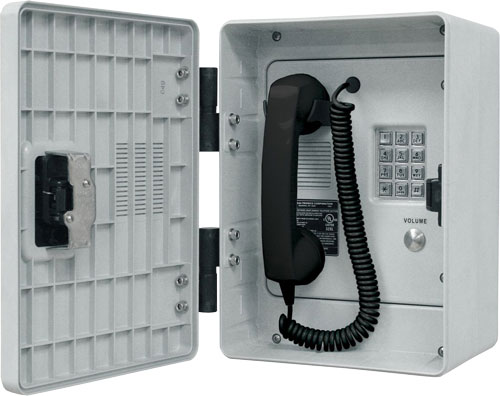
Build Quality: Features to Look For
For many situations, what durability standards the VoIP phone meets will be the most important thing to look for. However, there are other things you might want keep your eyes open for depending on the situation it’s to be used in. We cover wireless handsets and intercoms below, too.
Let’s say the phone meets your desired durability standards. What more? Noise cancellation is almost certainly going to be very useful. The right number of line keys for one-touch dialing to reach common extensions is very convenient. Beyond the durability standards covered above, you might look for the phone’s ability to withstand strong cleaning chemicals.
If you want to mount the VoIP phone on a wall, look for a panel phone. “Panel phone” means that the phone literally has a panel behind it, often made from stainless steel. If you don’t want a panel phone but just a regular VoIP phone, we strongly recommend you get the phone’s official wall mount bracket. We sell a full range of official mounts.
By the way, if you see “316 stainless steel” — which you might come across — this means that the steel is more corrosion resistant than other steels, which is why this is also called marine-grade steel.
Laser-etched graphics and numbers can be important, because then you don’t need to worry about them being rubbed off over time.
Finally, for a wired VoIP phone for harsh environments, an armored phone cord is good to have. You don’t have a tough phone with a plastic cord that gets destroyed right away.
Phone Enclosures
If the phone itself isn’t as durable as you want, look to protect it with a VoIP phone enclosure. An enclosure is, in essence, a durable plastic or steel container that holds the phone.
Enclosures are particularly useful to prevent corrosion, for example, in areas with a lot of salt in the air. In other words, if you’re working on or near the sea, an enclosure is a must. Enclosures are also almost a necessity if you’re installing the phone outdoors, particularly in locations with a lot of rain or snow.
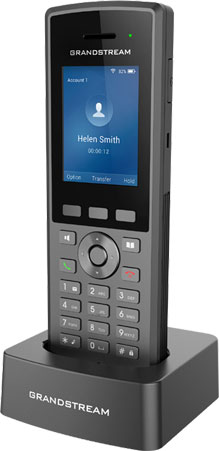
Ruggedized Wireless Handsets for Harsh Environments
Many businesses choose to go with less expensive yet still ruggedized options like the wireless handsets available from Grandstream. Wireless handsets are ultra-convenient, because you can carry them around with you wherever you go in the building. They’re also, typically, not very expensive.
The drawback to going with a wireless handset is that, no matter how ruggedized it is, it won’t be as long-term durable as, for example, a panel phone with steel faceplate. You have to balance having an expensive phone that’ll last for a decade or more vs saving money.
Wireless handsets come in two basic types: DECT and Wi-Fi.
A DECT handset connects to a VoIP base station; the base station then connects to the VoIP phone system. DECT is a well-established wireless communications protocol with a much better wireless range than Bluetooth or Wi-Fi.
A Wi-Fi handset is an independent VoIP phone that connects directly to the VoIP phone system via the wireless network. The big issue with Wi-Fi phones is that they require a good Wi-Fi connection wherever you’re going to use them. If your building has good Wi-Fi connectivity everywhere, then a ruggedized Wi-Fi handset like Grandstream offers is a good choice.
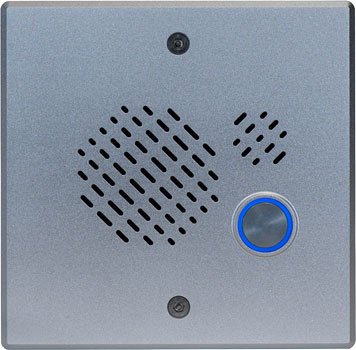
Ruggedized VoIP Intercoms: Another Communications Solution
While this blog has been focused on phones, many locations might be better suited to using rugged intercoms, like the VoIP intercoms available from CyberData.
The typical intercom will have a simple one or two button interface and a speakerphone. Some even have proximity sensors so you just have to wave to dial; you don’t even have to press a button. You can program it to dial a series of extensions. However, you can only dial these pre-programmed extensions. If you need to dial a variety of phone numbers, an intercom isn’t going to work. If you want a mobile solution, an intercom also doesn’t work.
One of their big advantages is that they’re ultra-simple and more visible than the typical phone. They come in a range of colors to improve visibility. A bright yellow intercom really sticks out on the factory floor, so everyone will be able to find it in an instant.
Many intercoms are also highly durable. For example, Viking Electronics offers VoIP intercoms with Enhanced Weather Protection, which is their term for a whole set of additional features to guard against environmental damage, including a potted circuit board, weather-proofing gaskets and more.
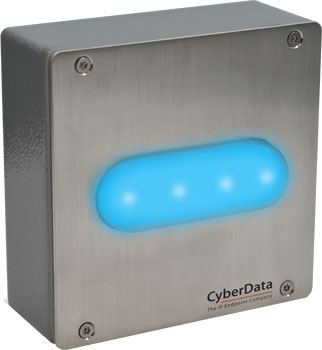
Dealing with Loud Environments: Loud Ringers and Strobes
Harsh environments often come with another problem: sound. What do you do when you can’t hear the phone ringing? In these cases, look for Loud Ringers and Strobes like the ones available from Algo.
A loud ringer for VoIP phones is exactly what you’d think: it’s a dedicated speaker that makes the ringer louder. If the environment is loud, but not so loud that you can’t hear anything above the din, a loud ringer is a good choice.
A strobe for VoIP is a dedicated light that provides a visual indication of a phone’s call status. If a call is coming in, it’ll light up. If the environment means workers have to wear ear muffs or other noise-reducing ear protection, a strobe is a must. Strobes are also useful for improving accessibility.
Want to know more? We covered loud ringers and strobes in detail: Loud Ringers and Strobes for VoIP.

